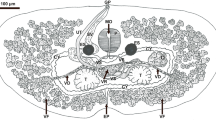Abstract
Deoxyribonucleic acid (DNA)-based insect identification has become a routine and accurate tool in forensic entomology. In the present study, we demonstrate the utility of the mitochondrial DNA cytochrome oxidase I gene “barcoding region” as a universal marker for molecular identification of forensically important Diptera. We analyzed 111 specimens belonging to 13 species originating from Frankfurt am Main, Germany (Calliphoridae: Calliphora vicina, Calliphora vomitoria, Lucilia ampullacea, Lucilia caesar, Lucilia illustris, Lucilia sericata, Lucilia silvarum, Phormia regina, Protophormia terraenovae; Piophilidae: Parapiophila vulgaris; Muscidae: Hydrotaea dentipes, Hydrotaea ignava, Hydrotaea similis). Intraspecific variation ranged from 0 to 1.17% and interspecific variation occurred between 1.17% and 15.21%. Although differences within species were generally less than among species, divergence percentages overlapped due to low interspecific nucleotide divergence of the recently separated sister species L. caesar and L. illustris. However, all species formed distinct monophyletic clades and thus the cytochrome oxidase 1 (COI) barcode has been shown suitable for clear differentiation and identification of forensically relevant Diptera in Germany.

Similar content being viewed by others
References
Amendt J, Richards CS, Campobasso CP, Zehner R, Hall MJR (2011) Forensic entomology: applications and limitations. Forensic Sci Med Pathol. doi:10.1007/s12024-010-9209-2
Ball SL, Hebert PDN, Burian SK, Webb JM (2005) Biological identification of mayflies (Ephemeroptera) using DNA barcodes. J N Am Bentholl Soc 24:245–255
Boehme P, Amendt J, Disney RHL, Zehner R (2010) Molecular identification of carrion-breeding scuttle flies (Diptera:Phoridae) using COI barcodes. Int J Legal Med 124:577–581
Desmyter S, Gosselin M (2009) COI sequence variability between Chrysomyinae of forensic interest. Forensic Sci Int Genet 3:89–95
Folmer O, Black M, Hoeh W, Lutz R, Vrijenhoek R (1994) DNA primers for amplification of mitochondrial cytochrome c oxidase subunit I from diverse metazoan invertebrates. Mol Mar Biol Biotechnol 3:294–299
Gregor F, Rozkosny R, Bartak M, Vanhara J (2002) The Muscidae (Diptera) of Central Europe. Folia Fac Sci Nat Univ Masaryk Brun, Biol, 107, Masaryk University, Brno, Czech Republic, 271 pp
Harvey ML, Dadour IR, Gaudieri S (2003) Mitochondrial DNA cytochrome oxidase I gene: potential for distinction between immature stages of some forensically important fly species (Diptera) in Western Australia. Forensic Sci Int 131:134–139
Harvey ML, Gaudieri S, Villet MH, Dadour IR (2008) A global study of forensically significant calliphorids: implications for identification. Forensic Sci Int 177:66–76
Hebert PDN, Cywinska A, Ball SL, deWaard JR (2003) Biological identifications through DNA barcodes. Proc Biol Sci 270:313–321
Hebert PDN, Penton EH, Burns JM, Janzen DH, Hallwachs W (2004a) Ten species in one: DNA barcoding reveals cryptic species in the neotropical skipper butterfly Astraptes fulgerator. Proc Natl Acad Sci USA 101:14812–14817
Hebert PDN, Stoeckle MY, Zemlak TS, Francis CM (2004b) Identification of birds through DNA barcodes. PLoS Biol 2:1657–1663
Meiklejohn KA, Wallman JF, Dowton M (2011) DNA-based identification of forensically important Australian Sarcophagidae (Diptera). Int J Legal Med 125:27–32
Nelson LA, Wallmann JF, Dowton M (2007) Using COI barcodes to identify forensically and medically important blowflies. Med Vet Entomol 21:44–52
Picard CJ, Villet MH, Wells JD (2011) Amplified fragment length polymorphism confirms reciprocal monophyly in Chrysomya putoria and Chrysomya chloropyga: a correction of reported shared mtDNA haplotypes. Med Vet Entomol. doi:10.1111/j.1365-2915.2011.00976.x
Reibe S, Schmitz J, Madea B (2009) Molecular identification of forensically important blowfly species (Diptera: Calliphoridae) from Germany. Parasitol Res 106:257–261
Rognes K (1991) Blowflies (Diptera, Calliphoridae) of Fennoscandia and Denmark. Fauna Ent Scand 24. E.J. Brill/Scandinavian Science Press, Leiden, New York, København, Köln
Sambrook J, Russel DW (2001) Molecular cloning: a laboratory manual, 3rd edn. Cold Spring Harbor Laboratory Press, Cold Spring, p 2344 pp
Schilthuizen M, Scholte C, Van Wijk REJ, Dommershuijzen J, Van der Horst D, Meijer zu Schlochtern M, Lievers R, Groenenberg DSJ (2011) Using DNA-barcoding to make the necrobiont beetle family Cholevidae accessible for forensic entomology. Forensic Sci Int. doi:10.1016/j.forsciint.2011.02.003
Schroeder H, Klotzbach H, Elias S, Augustin C, Pueschel K (2003) Use of PCR-RFLP for differentiation of calliphorid larvae (Diptera, Calliphoridae) on human corpses. Forensic Sci Int 132:76–81
Smith KGV (1986) A manual of forensic entomology. Cornell University Press, London, p 205 pp
Sperling FAH, Anderson GS, Hickey DA (1994) A DNA-based approach to the identification of insect species used for postmortem interval estimation. J Forensic Sci 39:418–427
Stevens JR, Wall R, Wells JD (2002) Paraphyly in Hawaiian hybrid blowfly populations and the evolutionary history of anthropophilic species. Insect Mol Biol 11:141–148
Wallman JF, Leys R, Hogendoorn K (2005) Molecular systematics of Australian carrion-breeding blowflies (Diptera: Calliphoridae) based on mitochondrial DNA. Invert Syst 19:1–15
Ward RD, Zemlak TS, Innes BH, Last PR, Hebert PDN (2005) DNA barcoding Australia’s fish species. Philos Trans R Soc Lond B 360:1847–1857
Wells JD, Stevens JR (2008) Application of DNA-based methods in forensic entomology. Annu Rev Entomol 53:103–120
Wells JD, Wall R, Stevens JR (2007) Phylogenetic analysis of forensically important Lucilia flies based on cytocrome oxidase I sequence: a cautionary tale for species determination. Int J Legal Med 121:229–233
Zehner R, Amendt J, Schütt S, Sauer J, Krettek R, Povolný D (2004) Genetic identification of forensically important flesh flies (Diptera: Sarcophagidae). Int J Legal Med 118:245–247
Acknowledgments
The authors thank Sabrina Peddinghaus (RWTH Aachen University), Heike Fremdt (Goethe-University Frankfurt), and Dr. Krzysztof Szpila (Nicolaus Copernicus University) for providing specimens and morphological identification. Thanks to Dr. Christine Picard and Dr. Baneshwar Singh (Texas A&M University) for helpful suggestions.
Author information
Authors and Affiliations
Corresponding author
Rights and permissions
About this article
Cite this article
Boehme, P., Amendt, J. & Zehner, R. The use of COI barcodes for molecular identification of forensically important fly species in Germany. Parasitol Res 110, 2325–2332 (2012). https://doi.org/10.1007/s00436-011-2767-8
Received:
Accepted:
Published:
Issue Date:
DOI: https://doi.org/10.1007/s00436-011-2767-8




